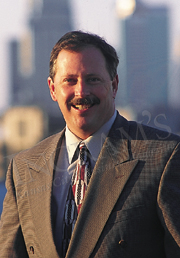
Some of my fondest memories at Mizzou are
of intramural sports and how my ATO frat brothers and I would battle the
cross-campus rival Betas for one championship or another. Football was
always the biggie, (however we swept them from ’77 through ’80),
and that clash was as much a tradition at MU as the Columns themselves.
Our idea of strategy at the time was to throw the football around and
speculate aimlessly about our next game. In that era, the notion of “focusing”
was something of a challenge, what with locker-size speakers blasting
out of the fourth-floor windows, a competing game of Zeta ball in the
front lawn, the Tri-Delts sunbathing next door and the non-harmonious
sounds of Marshall Tucker clashing with Styx coming from the area houses.
One year we clinched the fraternity championship and played the dorm league
champs for the crown. After nearly scoring on the opening kickoff (with
touch football it’s almost impossible), we huddled the return team
and I remember saying that we can break this thing—let’s form
the wedge, extend the blocks and run like hell. That was the first of
three TD runbacks in what became a 40-point trouncing of the dormies.
This spontaneous and improvised strategy was what it took to win, but
only due to our opponents’ lack of strategy to combat it.
Sometimes, the Kansas City area’s level of strategic discussions
seems as improvisational as our intramural league’s. The difference
is that, at this level, we can’t count on our competition to be as
equally unfocused.
As a native Kansas Citian and a cheerleader of this community, I can say
with confidence that we possess the chemistry to not only compete, but
to create one of the most thriving business regions in the nation. But
it will take an adjustment to our plan and a coordinated effort between
government and business leaders in area cities, counties and the bi state
to make it work. It will require less competition among us and more cooperation.
This edition of Ingram’s is a unique one, particularly as it relates
to the identification and understanding of some of the impediments to
our regional progress. This issue also represents the sixth anniversary
of our ownership of this 28-year-old publication, during which time we
have developed significant institutional memory on area business trends.
Hospitality and Tourism The Kansas City area has yielded a 7-percent increase
in hotel rooms from 1999 to February, 2002, (from 25,057 to 26,801) and
appears substantially off-track in filling these rooms, recruiting traffic
and using our area convention and meeting facilities.
The Hospitality in Kansas City feature beginning on page 25 gives an historic
perspective of where we’ve been and how Kansas City may be losing
its competitive edge. Ironically, we continue to build, and suggest to
build, more hotels and meeting and convention space, but we underutilize
what we presently have. I think that we should invest in these facilities
out of a point of strength, not to “compete” with other cities,
particularly those with steady hospitality and tourism traffic.
Transportation This month we explore perhaps the region’s most essential
industry thus far—transportation. While the bi state region has a
well-planned road system, we must continue to fund its upkeep and explore
more efficient modes of transportation. Although the area’s growth
is not restricted by natural impediments, our centrality and the advancements
in infrastructure put the Kansas City area absolutely at the nexus of
North American trade.
It seems logical that both states should invest significantly to maintain
and develop our infrastructure. One possibility is to rebuild I-70 as
a Smart Highway tech corridor and integrate a high-speed rail system connecting
St. Louis to the east. The 10,000 acres of land surrounding KCI offers
another excellent opportunity for creation of a mid-American distribution
center.
This volume of Ingram’s has been an exciting one to create. I’m
of the belief that if we recruit a collaborative team of passionate area
leaders, we’ll create the right chemistry to exploit the region’s
centrality, affordability, work ethic and connectivity and, in the process,
build one of America’s greatest cities. Victories are sometimes won
on talent alone, but a little bit of strategy always helps.
Enjoy this edition, and as always, your response is appreciated.
